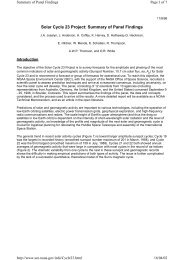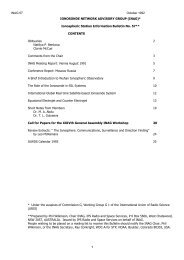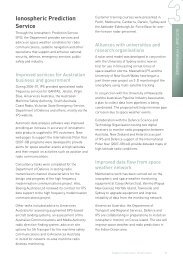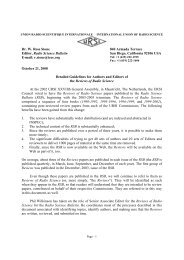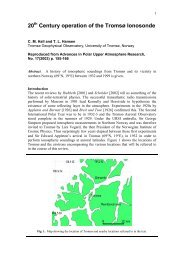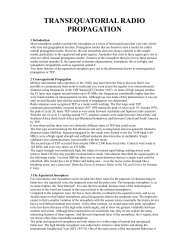UAG-93: Chapters 1 to 5 - URSI
UAG-93: Chapters 1 to 5 - URSI
UAG-93: Chapters 1 to 5 - URSI
You also want an ePaper? Increase the reach of your titles
YUMPU automatically turns print PDFs into web optimized ePapers that Google loves.
The ultimate model for single-1ayer calculations would seem <strong>to</strong> be one which maintained the<br />
continuity of a1l derivatives ai al1 points. This impiies the use of a single mathematical expression<br />
<strong>to</strong> represent the entire profile. The mathematics impljcit in this idea are tractable provided that<br />
the adopted expression is differentiable. For any set of scaling frequencies a matrix of coefficients<br />
can then be obtained giving the real height at each frequency directly in terms of the observed<br />
virtual heights. l,lith the entire real-height profile represented by a single analytic expression'<br />
coefficients can be determined which give any required parameters of the real-height profile directly.<br />
Thus the peak height, the scale height at the peak and the sub-peak electron content can be obtained<br />
directly irom the-measured virtual 6eights without the need for calculating any other aspects of the<br />
orofi I e.<br />
Increased accuracy is obtained by requiring a parabolic peak at the observed critical frequency.<br />
For a single-'layerionogram the results are then quite acceptable with only a small numben of data<br />
points; i 5-point analysis gives values of peak height which are an order of magnitude more accurate<br />
than those obtained using Keiso-Schmerling coefficients (Titheridge, 1966). Tables are available for<br />
the analysis of ionograma taken anywhere in the world, using 5 or 6 measured vjrtual heights<br />
(Titheriige, 1969; Piggott and Rawer, 1972). l.lith this number of poirrls the results are completely<br />
stable, ana Oy choosing either the 5- or 6-point frequency grid 1a|ge cusps on the ionogram.can be<br />
avoided. Coeificients are also gjven for the analysis of night-time ronograms, usjng 5 ordinary and 1<br />
extraordinary ray measurement; the resulting profile is then approxinrately corrected for the effects<br />
of group retardation in the night-time E region.<br />
2.3 0verlapping Polynomials<br />
Accurate calculations require accurate interpolatjon between observed frequencies. The Kelso<br />
method applies Gaussian interpolation io the virtual heights. In other methods interpolat.ion is done<br />
'in the rbit-neight domain, since the real-height curve is considerably smoother. As in most problems<br />
of fitting disciete data points, accuracy is initially improved by an increase in the order of the<br />
interpolaiing polynomial. A limit is reached, however, beyond which the results become unstable.<br />
There is theieiore an optimum number of terms (n) for the polynomial. When the number of data<br />
points <strong>to</strong> be fitted is greater than n, a different interpolating polynomjal is used.for each interval.<br />
For maximum accuracy, the polynomial should be fitted <strong>to</strong> data on B0Tf1 sides of the interval<br />
considered.<br />
In many problems interpolation polynomjals $/ith 4 <strong>to</strong> 6 terms are about optimum. For ionogram<br />
analysis, oscilla<strong>to</strong>ry tendencies begin with 7 terms at large magnetic dip angles, and with 6 terms<br />
near the equa<strong>to</strong>r (Titheridge, 19i5a). Five terms were therefore adopted for the polynomial used <strong>to</strong><br />
represent the real-height curve between successive data points. This gives the fourth-order<br />
over'lapping polynomial analysis LAP0L (Titheridge, 1967b, 1974a). in this method the real height<br />
between two given frequencies is represented by a fourth order polynomial, which is fitted <strong>to</strong> two<br />
points on eilher side of the interval considered. Gradients are also matched at the ends of each<br />
interval. This gives five constraints which are used <strong>to</strong> determine the five parameters for each<br />
polynomial.<br />
Procedures can be constructed in which the polyncmial is defined b;v real heights at a number of<br />
points on either side of the interval considered, and by specifled derivatives at some of these<br />
points. Virtual heights hi' are then expressed in terms of the polynomi;:l coefficients, usins (1)'<br />
and the resulting eqiations'inverted <strong>to</strong> obtain the real-height pararneter:'," The computational<br />
complexity of this process can, however, become prohibitive. |^Jith llrlrth-ordcr polynomials' and<br />
virtual niignts measured at 60 frequencies, the 300 parameters Cefining tne real-height profile would<br />
be obtained by solving a set of 300 simultaneous equations. This cannot be done efficiently or<br />
accurately. i1atching-of derivatives at frequencies above the central jnterval of each polynomial is<br />
therefore replaced by matching of virtual heights. There seems little if any Cisadvantage 11 this .<br />
approach, which enabies a simple step-by-step analysis. The virtual-height data contains all that is<br />
knbwn about the profile; virtual-height matching therefore implies a simultaneous matching of al1<br />
available information, whether this relates <strong>to</strong> true heights or <strong>to</strong> derivatives.<br />
Successive polynomials fit the same real height at the joining points, since the real height<br />
calculated from one section is used as a constraint in the next. If two adjacent polynomials are also<br />
required <strong>to</strong> give the same virtual height at the joining point, the gradients must match closely at<br />
that point (iince the virtual height at any frequency depends most closely on the gradient at that<br />
frequency). l,lith 5-term poJynomials we get 5 simultaneous equations at each step. Shifting the<br />
origin <strong>to</strong> tne last calculated real height gives well-conditjoned 4 x 4 matrices, and errors in the<br />
matiix inversion of less than 1 part in 106 using standard 24 bit precision (Titheridge' 1967b).<br />
In tests using a number of different real-height profiles with various frequency intervals and<br />
dip angles, the 5-term overlapping-polynomial analysis gives results which are 100 <strong>to</strong> 1000 times more<br />
accuraie than using parabolic lamjnations (Titheridge, i975a, 1978). The stability of the analysis'




